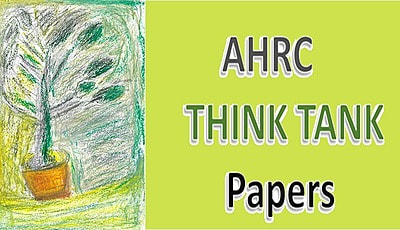SRI LANKA: Autochthonous constitutions, indigenous commissions and homegrown lawlessness
These days, there is a great deal of discussion about what is autochthonous, what is indigenous and what is homegrown. Contemporary discussion on the proposed commission for reconciliations and lessons learned according to the Minister for the Media will be an indigenous one. During the last three to four decades, Sri Lanka has experimented with an autochthonous constitution. However, the overwhelming experience of Sri Lanka throughout the country remains one of homegrown lawlessness, which has descended to the level of child trafficking. The use of language, therefore, to give an appearance of something uniquely Sri Lankan works to cover up a blatant abuse of power, and for the purpose of deception, needs to be examined closely if cheating on the basis of nice words but extremely bad social experiments are to be prevented.
In 1972, the coalition government which consisted of the Sri Lanka Freedom Party and the countrys well known Marxist parties, talked about an autochthonous constitution. It was said that the Soulbury Constitution was in fact a foreigners constitution, one which was not homegrown. However, what was the type of autochthonous constitution that the countrys well know intellectuals of the time, such as Colvin R De Silva, Felix Dias Bandaranayaka, NM Perera, and many other people who were involved in the drafting of the 1972 Constitution brought about? The primary aim of the 1972 Constitution was to undermine the power of the judiciary. There was a homegrown fear among the so-called leftists of the time that the Supreme Court was conservative. They created the impression that they were involved in progressive experiments for the larger masses and that the conservative Supreme Court may stand against these experiments. For that purpose, the idea of the supremacy of the Parliament – in which the supremacy of the people was to be expressed – was put forward. Under the concept of peoples sovereignty was in fact, the idea of the undermining of the judiciary. It was pretended that the sovereignty of the people was being challenged by the separation of powers concept on which judicial power rested. Undermining judicial power in favour of the peoples sovereignty was in fact an attempt to get greater power in the hands of the executive. The role of the permanent secretaries was dismissed in favour of the power of the cabinet, once again to exercise peoples sovereignty. Permanent secretaries were seen to be an obstacle to the peoples sovereignty.
This autochthonous constitution making came to its zenith with the making of the 1978 Constitution. In this constitution, the idea of the peoples sovereignty was used to do away with the separation of powers concept altogether. All power was to be placed in the hands of the executive, who was then placed above the law by this constitution. The western notion of the peoples sovereignty – which meant the supremacy of the rule of law over the executive – was rejected as an alien concept. Thus, what was really being removed on the basis of the peoples sovereignty is the fundamental notion of the rule of law. Sovereign people can give power to the executive to arbitrarily make the laws he wants, whenever he sees fit. This kind of language twist to give the appearance of an indigenous concept of the peoples sovereignty worked to make the people powerless. The sovereign people became increasingly powerless before an overwhelming power of the executive, this is the way the peoples sovereignty is being exercised in Sri Lanka under this autochthonous constitution.
The result of all this becomes very clear. This is apparent in the recent cases of people who were removed from their houses by arbitrary action of the executive and are now living in slum-like conditions at Slave Island. All these people have property deeds which are legitimate before the law. If they were to be removed under a rule of law situation, it would have been necessary for the government to legally acquire the land by making alternative arrangements for the tenants first. In the normal course of application of the law, that the people would receive just compensation for their lands and an alternative place to live would be guaranteed, prior to them being removed. There would not have been a situation where people were thrown onto the streets, when children had to cry out to the media that they have no place to sleep and no school to go to; such is the homegrown lawlessness that is growing in the country.
The greatest example of the colossal lawlessness in the country is the nature of the Sri Lankan policing system itself. Constant custodial killings of innocent people, absolute impunity enjoyed by police officers, widespread corruption, absence of any command responsibility and absolute control of the top of police, the IGP and other officers, by the executive are normal experiences in the country today. In the midst of this, there are no solutions to robbery, murder, rape and many of the crimes that take place without people having any kind of protection. A symbol of the countrys lawlessness is the disappearances that have taken place in Colombo in recent years. The recent reports in the media talk about six hundred disappearances around the time of the final conflict with the LTTE. The last of such disappearances is the case of Prageeth Eknaligoda, a well-known journalist and father of two children. The police are unable to account for this disappearance. Such is the dark hour of lawlessness in the country. It is completely homegrown because there was no conspiracy by anybody that has brought about this lawlessness. The countrys lawlessness is a product of constitutional experiments: experiments relating to the law and experiments relating to an attempt to oust the peoples sovereignty. The sovereign people have to live without the protection of the law. Such is the nature of homegrown lawlessness in the country.
It is this kind of problems that Sri Lanka has to address in the aftermath of the countrys bitter civil war. It has been one year since the military victory against the LTTE. The media speculated that once Prabhakaran was removed from the political scene, the country would come to a period of milk and honey. However, the country has not yet come to any kind of stability or progress. Civilians are becoming increasingly powerless as corruption and lawlessness spreads and they find that they have nothing to resort to as violent forces destroy their basic livelihoods.



